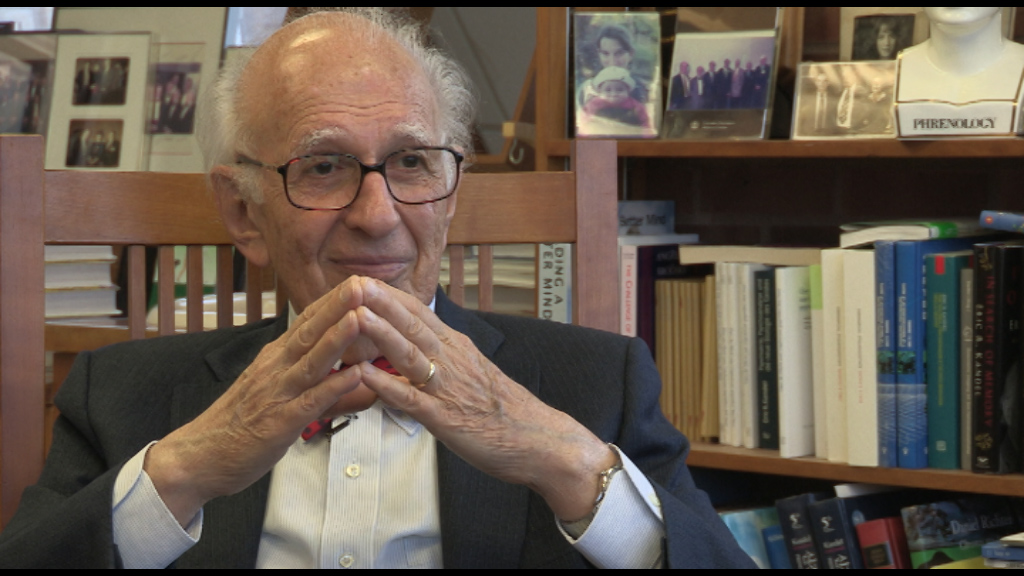NEXT STORY

The characteristic features of prions
RELATED STORIES

NEXT STORY

The characteristic features of prions
RELATED STORIES


|
Views | Duration | |
|---|---|---|---|
| 41. Cell accepts my article for publication | 98 | 03:09 | |
| 42. Discovering the machinery for turning on long-term memory | 73 | 03:08 | |
| 43. Investigating the initiation and maintenance of long-term memory | 44 | 05:28 | |
| 44. What is so special about prions? | 71 | 04:42 | |
| 45. The characteristic features of prions | 47 | 01:34 | |
| 46. Alden Spencer | 48 | 05:12 | |
| 47. S Channel | 30 | 01:50 | |
| 48. How a review inspired a textbook | 42 | 02:19 | |
| 49. Coincidences that influenced my work | 62 | 04:39 | |
| 50. Nurturing the ideas of post-doc students | 49 | 00:54 |


At this particular point, Kelsey leaves the lab, and I go into a funk. Fortunately, Kausik Si comes along, and he picks up where Kelsey leaves off. And he had a very interesting background. Terrific kid, from India. Many of my best post-docs are Indian – Priya Rajasethupathy, Pramod Dash – outstanding. He had worked with yeast which came in handy later on. So he argued, if you're going to send gene products all over, as the marking signal suggested, you probably want to have the gene products in the dormant form, otherwise they might be promiscuously activated at inappropriate synapses. So he said, you know, there's evidence for this. In Xenopus oocyte one had found that mRNAs have a short poly(A) tail, so they're not recognized by the ribosomes, but there's a special regulator of protein synthesis called the cytoplasmic polyadenylation element binding protein (CPEB) that carries out cytoplasmic polyadenylation that allows the mRNA to have a longer poly(A) tail, now to be recognized and translated by the ribosomes.
So he looked for CPEB in Aplysia, and he found, in addition to the developmental isoform that had earlier been described, a novel isoform that had never been described, that had a peculiar end terminus. And he looked to see whether or not this was affected by serotonin. And he found, sure enough, that if he gave even a single pulse of serotonin, it was increased in its level of expression at the terminals. Okay? So it was present at the terminals, and increased in levels of expression. Moreover, if he injected an antisense oligonucleotide against this, he got long-term facilitation, but it was not maintained. So then he was curious, you know how does this function? So he sequenced [the isoform], and he saw [that the protein] had a very peculiar ending – a peculiar N-terminal. It was very rich in glutamine residues, in polar residues. And this is exactly what one had seen in yeast cells with prion proteins. In fact, he showed that 50% of the N-terminus were these polar residues. He then looked to see what the Drosophila CPEB was; it was exactly the same. So that was very encouraging, and since he had experience in yeast, and Susan Lindquist helped us with this, he put this into yeast and showed it had all the characteristics of yeast prion.
What is so special about prions? They exist in two forms: a soluble form and an aggregated form. The soluble form can get recruited in the aggregate form, and leads to a self-perpetuation of the aggregate form. So as proteins drop off the aggregate form, new ones form, and as soon as they touch the aggregate, they get transformed, so they're capable of joining the aggregate.
Moreover, this aggregated form was self-perpetuating, and he showed all of these characteristics. And then he was able to take this to Aplysia and show that all of these characteristics apply. That is if you express it at high levels it forms aggregates. If you chop off the N-terminus, which has these polar residues, you lose the aggregate formation. If you give serotonin, it increases aggregate formation. Chop off the N-terminal, you lose it. He then developed a specific antibody that recognized only the aggregated form, and he blocked the maintenance, but not any other part of the facilitation. So this was really quite a remarkable finding, and it suggested that we had a new category of prion.
Eric Kandel (b. 1929) is an American neuropsychiatrist. He was a recipient of the 2000 Nobel Prize in Physiology or Medicine for his research on the physiological basis of memory storage in neurons. He shared the prize with Arvid Carlsson and Paul Greengard. Kandel, who had studied psychoanalysis, wanted to understand how memory works. His mentor, Harry Grundfest, said, 'If you want to understand the brain you're going to have to take a reductionist approach, one cell at a time.' Kandel then studied the neural system of the sea slug Aplysia californica, which has large nerve cells amenable to experimental manipulation and is a member of the simplest group of animals known to be capable of learning. Kandel is a professor of biochemistry and biophysics at the College of Physicians and Surgeons at Columbia University. He is also Senior Investigator in the Howard Hughes Medical Institute. He was the founding director of the Center for Neurobiology and Behavior, which is now the Department of Neuroscience at Columbia University. Kandel's popularized account chronicling his life and research, 'In Search of Memory: The Emergence of a New Science of Mind', was awarded the 2006 Los Angeles Times Book Award for Science and Technology.
Title: What is so special about prions?
Listeners: Christopher Sykes
Christopher Sykes is an independent documentary producer who has made a number of films about science and scientists for BBC TV, Channel Four, and PBS.
Tags: Kausik Si
Duration: 4 minutes, 42 seconds
Date story recorded: June 2015
Date story went live: 04 May 2016